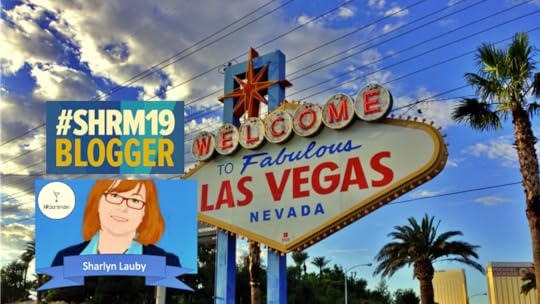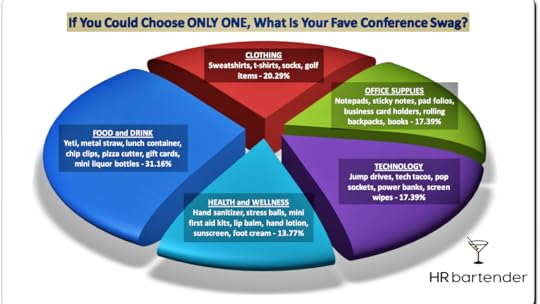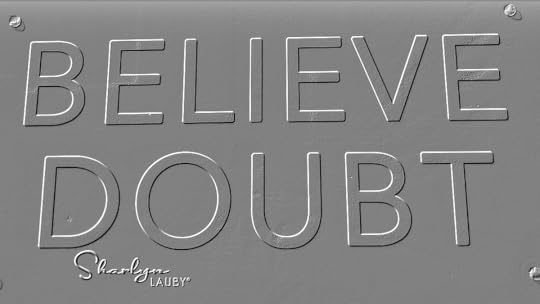Sharlyn J. Lauby's Blog, page 97
June 7, 2019
Bookmark This! Building Trust Into the Employee Value Proposition

In today’s competitive recruiting landscape, one of the things that organizations need to focus on is their employee value proposition (EVP). The EVP comprises all of those “things” that employees get by working for your organization. It includes:
Compensation, benefits, and perks
Work environment (i.e. what does the place look like?)
Training and career development
Rewards and recognition
Management
Organizations want their EVP to be competitive in the job marketplace. Frankly, even in a less competitive job market, it just makes good business sense to promote this information. I recently wrote a series of posts on the Workforce Institute at Kronos Incorporated blog about the employee value proposition and specifically focused on adding the component of trust. I wanted to share them with you over here.
5 Currencies Essential to Your Company’s Employee Value Proposition. Letting employees know the currencies – both monetary and non-monetary –they will receive helps them decide whether to work for an organization. Once hired, providing ongoing communications about the EVP can impact the degree to which an employee engages with the organization and whether they want to stay.
4 Steps Toward Building a Recruiting Process that Creates Employee Trust. Good processes will yield good outcomes. Organizations that want to hire the best talent need to have an excellent recruiting process because candidates have choices. Sometimes, many choices! And if the organization wants candidates to choose them, then understanding how to build trust in the recruiting process is essential.
How to Create a Trusting Company Culture. Trust is essential in today’s business world. This isn’t just the latest trend du jour. It’s also not a generational thing. Every age group wants to work with dependable people and in a place they can trust. Companies that focus on building trusting cultures will win the talent wars and the customer wars too.
When it comes to building trust, the best approach is a proactive one. Just like customers who buy from companies they trust, employees want to work for organizations that they trust. It’s essential for businesses to show candidates and employees that they’re trustworthy. And in the unlikely chance that something happens to question the company’s trust, the organization needs to have a plan to get it back. It’s better to have this discussion and never use it than scramble after the fact.
The post Bookmark This! Building Trust Into the Employee Value Proposition appeared first on hr bartender.






June 6, 2019
Should Employees Be Able to Listen to Music While They Work [poll]
Did you see the Society for Human Resource Management (SHRM) Express Request on music and productivity? There’s quite a bit of research indicating that listening to music can help individuals be more productive. If you don’t have access to the SHRM site, here are a few articles on the issue:
The Science Backed Ways Music Affects Your Brain and Productivity
Enhance Focus with Productivity Music (Recommended Playlists)
The reason the articles caught my attention is because I like listening to tunes when I work. Especially when I travel. Just put on the headphones and start writing.
Now I will admit the type of songs I listen to has evolved over the years. I went through this phase where I would only listen to Mozart because I read somewhere about The Mozart Effect and that classical music is the perfect background sound at work. And no offense to my friends who love classical, but that didn’t cut it for me. I enjoy a wide variety so now I listen to the tunes I like.
But listening to music has not always been a part of my work routine. When I worked in hotels, we didn’t listen to music out of respect for the culinary team. As much as the cooks wanted to listen while they worked, the executive chef wouldn’t allow it for safety reasons. They didn’t want it to distract employees and create a situation where the employee could get burned or cut. Since the cooks didn’t listen to music, we didn’t listen to music.
I’m curious to know your thoughts. I’ve set up an anonymous survey – it should take less than 2 minutes– on Survey Monkey with just two questions:
Should employees be able to listen to music while they work?
What’s your favorite “work” song?
I think it would be fun to see what others are doing as well as put together a little “listen while you work” playlist (see what I did there? LOL!). Thanks for weighing in on this survey. I know we’ve done a few surveys lately and I appreciate your feedback. I know other readers do as well. Stay tuned to see the results!
The post Should Employees Be Able to Listen to Music While They Work [poll] appeared first on hr bartender.






June 4, 2019
3 Reasons Your Organization Should Focus On the Employee Experience
Work is an fundamentally important part of our lives. It’s important for businesses because work is what helps them achieve their goals, mission, vision, etc. Work is important for employees because they spend a significant portion of their time doing work. They need work to pay the bills and provide for their family.
So, organizations need to spend some time thinking about how employees want to work. And try to deliver that kind of employee experience. Because candidates are going to apply and accept job offers from companies that offer the type of work that they feel they will enjoy.
Don’t misunderstand the word “enjoy” in the last sentence. We’re not talking about something frivolous or silly. There are plenty of employers that offer what might be considered hard work and employees love working there because the employee value proposition (EVP) aligns with their work wants and needs.
Given today’s competitive recruiting landscape, organizations can’t simply set and forget their EVP. Companies might want to make the commitment to regularly audit or conduct an EVP pulse check. In fact, it could make some sense to even publicly announce to employees that the company is committed to doing so.
I remember working for a company that told employees they would annually benchmark compensation and benefits to ensure they were paying wages that were internally fair and externally competitive. Conducting the benchmarking activity didn’t always result in changes, but the company was very open about their commitment.
For companies that might be sitting on the fence about this idea, there are three primary reasons that organizations need to regularly examine their employee experience:
It’s the right thing to do. I do not believe any organization sets out to create a crappy work environment. Unfortunately, it sometimes happens over time. Making the commitment to offering an excellent employee experience is simply the right thing to do. That includes taking action when things go astray.
It helps deliver good customer service. It’s very difficult for unhappy, stressed, burned out employees to deliver exceptional customer service. There’s a lot of truth in the statement that “happy employees deliver good customer service”. Creating a positive work environment helps the customer relationship.
It resonates with customers. Speaking of customers, there’s a trend that organizations need to pay attention to. Customers are making buying decisions based on the perception they have about the company as an employer. Treat employees badly and your customers might decide to go to your competition.
Work continues to be an important part of our lives, so how we do the work is an important part of the employee experience. And that’s a key factor not only in the area of employee recruitment and retention but also from the company’s bottom-line results.
The post 3 Reasons Your Organization Should Focus On the Employee Experience appeared first on hr bartender.






June 2, 2019
10 Things I Am Packing In My #SHRM19 Conference Bag
Last year, in addition to my annual post with tips for attending the Society for Human Resource (SHRM) Annual Conference, I wrote a post about some of the things that I carry with me during the event. Not only was it a nice reminder for me when I’m packing, but I received several good comments from readers. So, I’m doing a 2019 version for this year’s event which will be held June 23-26, 2019 in Las Vegas. I hope you find it helpful for SHRM or any conference you attend.
The “bag”. I will admit, I rarely carry the official conference bag. But I do bring with me a backpack or tote that will sufficiently hold my conference stuff. It needs to be comfortable to walk around with and durable. I have a classic black Vera Bradley tote that holds up well and just recently purchased a Hershel backpack that’s nice to carry. PRO TIP: If you’re new to conferences, let me tell you . . . you don’t have to take everything a vendor wants to hand you. Ask them to scan your badge and send the information you want. Trust me, they will.
Ilike having the flexibility of more than one device, so I bring both my iPhone and iPad. The smart cover for my iPad is terrific for typing and it’s not as heavy as a laptop. Oh, and make sure you download the SHRM conference app as well as the SHRM Certification app ahead of time. While there will be WiFi at the convention center, it won’t be like your home or office WiFi.
Charger, cords, and plug. Yes, I know this is low-hanging fruit, but I remain amazed at the number of people who don’t do it. They have the cord, but no plug. Or the charger and no cord. I love my Anker portable charger which does a great job. And I equally love this Belkin rotating plug. It allows me to share an outlet with friends.
Business cards. Sometimes you meet someone at the event and don’t have time to chat but want to stay in touch. Grab their business card then connect with them later or on LinkedIn. Always, always, always have a handful of business cards available. PRO TIP: If you don’t have business cards, there’s still time to order a nice MOO Card with your contact info in time for the conference.
Notebook. As much as I love technology, I also like taking notes on paper. And, there’s some research that shows writing things down can be the key to remembering important information. So, I love it when vendors provide a small Moleskine type notebook. PRO TIP: I bring a shipping label with me and tuck it in my notebook so I can mail home books, swag, vendor materials, etc.
Pens and highlighters. Vendors, please take note: There’s nothing better than writing with a nice pen. And having a good highlighter. That doesn’t mean it has to be expensive. It just means nice. ‘nuf said.
Water bottle. In an effort to be more eco-aware, I try to take water bottles with me versus buying bottled water onsite. It’s also great for my budget. My new go-to is S’well or those brands like it. It keeps beverages cold and has a nice secure lid.
Insta-beverages. You guys know I’m a tea person and one of my biggest peeves in life is the lack of good tea when traveling. To reduce my frustration, I travel with tea bags. I also recently found some delightful instant tea latte mixes from a company called Girnar. That way when I want something, but the coffee shop lines are too long (and they always are!)…I’m covered.
Snack. Along the same line of having a beverage option ready, I also try to have some sort of snack. If the lines are too long for lunch or the lunch options don’t appeal to me, I’ll have a protein bar or some trail mix for lunch. It takes the edge off and I’ll just have an early dinner.
Something to pass the time. There are moments when I’m just waiting – maybe before a general session, or for a bus back to the hotel, or I just want a few moments to myself. I try to have something that serves as a little distraction. I lean toward puzzles like Sudoku or Wordscapes. There’s no rule that we have to be learning all the time.
Going to conferences is educational, inspirational, and at times, just plain fun. But to get the most out of the event, it helps to be prepared. The SHRM Annual Conference is large (huge, really). This isn’t one of those, “Oh, I forgot that…let me pop over to my room and get it.” So, plan ahead and have a wonderful time.
Image captured by Sharlyn Lauby after speaking at the SHRM Annual Conference in Las Vegas, NV
The post 10 Things I Am Packing In My #SHRM19 Conference Bag appeared first on hr bartender.






May 31, 2019
Do Your Employees Have Heart – Friday Distraction
(Editor’s Note: Today’s post is brought to you by our friends at Kronos , a leading provider of workforce management and human capital management cloud solutions. Want to create an inspired workforce with more heart? Check out Kronos CEO Aron Ain’s new book “ Work Inspired: How to Build an Organization Where Everyone Loves to Work ”. Enjoy the article!)
I’ve noticed some articles recently that talk about the idea of following your passion when it comes to your career as being passé advice. I get it. Not everyone has a passion. Not everyone wants the pressure of creating a passion.
But that doesn’t mean employees can’t have or shouldn’t have heart. While this Time Well Spent from our friends at Kronos was a play off from Valentine’s Day, it has a message that applies year-around. To me, having heart is about strength and perseverance. We want employees to enjoy their work, focus on customers, and be proud of the company. Even if they’re not following their passion, work doesn’t need to be drudgery.
This places some pressure on career development programs to back off the notion that everyone has a passion and they need to follow it. Here are a few things to consider:
Instead of saying passion, call it rewarding. I think it’s fair to say that people want rewarding work and to be productive. Regardless of their passion, employees don’t want to have their time wasted or unappreciated. Ask employees to spend some time thinking about what is rewarding about work. Maybe a follow-up question is to find out what makes them feel productive and/or unproductive.
Use one-on-one meetings to receive employee feedback. This ties into the first bullet point. Managers should ask employees to share the answers to the workplace questions during one-on-one meetings. Companies want to create work environments that allow employees to feel rewarded and be productive. This will lead to employee engagement and, ultimately, retention.
Support employee self-management training. If employees are struggling to find their most productive selves, consider giving employees the tools to discover the answers. Self-management training can provide employees with insights about themselves and the way they like to solve problems, resolve conflict, and make decisions. These answers can help employees identify their most productive selves as well as what makes them feel rewarded.
Employees want to have heart about their work. I believe they want to care about their responsibilities and the results. Organizations want the same. So, if individuals or organizations think that a little heart is missing, are they asking themselves why. And putting some activities in place to rekindle work that is rewarding and productive.
The post Do Your Employees Have Heart – Friday Distraction appeared first on hr bartender.






May 30, 2019
The Conference Swag HR Pros Want Most #SHRM19
A few weeks ago, I asked the question, “What’s your favorite type of conference swag?” A huge thanks for sharing your thoughts! I must say that I’m a bit surprised at the results. Here they are:
Food and drink related items were at the top of the list. I wasn’t surprised at the requests for Yetis – they’re one of my all-time personal faves. But I was happily surprised at the mentions of stainless straws and chip clips. I’m hoping we see both of those in the expo this year.
Coming in second was clothing, another surprise to me. I would have put t-shirts a lot further down on the requested conference swag list. And it was interesting to hear about the number of people who are into conference socks! They’re a collectable item.
Tied for third place were office supplies and technology. Let’s address office supplies first. Personally, I love good office supplies – nice pens, good highlighters, fun sticky notes, and journals are great. Cheap office supplies are well, cheap. If you’re going to give away office supplies, they need to be top notch.
I was surprised that technology placed so low. The only thing I can figure is that people want the technology accessories that they want, so tech swag isn’t appealing. I can also see some tech swag not being compatible with all devices, which may be a drawback.
Finally, health and wellness was last. I don’t believe this is because people don’t want to take care of themselves. The conversation about wellbeing and self-care is at an all time high. Like technology, I figure that people have their own preferences, so it becomes difficult to make everyone happy.
I’m really hoping that there are a bunch of HR conferences and HR vendors that take this list seriously. First, there are some really original ideas for conference swag! Second, the last thing any event wants to do is buy a bunch of swag that no one wants. Marketing departments do not want to come home from a major event with boxes of leftover swag. What they want is to run out of swag. They want people to take pictures of their swag and post it on Instagram.
So, here’s to finding your favorite conference swag at the Society for Human Resource Management (SHRM) Annual Conference. Or frankly at any event you attend.
The post The Conference Swag HR Pros Want Most #SHRM19 appeared first on hr bartender.






May 28, 2019
Innovation and Leadership: 7 Qualities Organizations Need for Success
In the January issue of Harvard Business Review, there was an article about the qualities of innovative company cultures. It’s a great read that you should check out when you have a moment.
My takeaway from the article was that innovation shouldn’t be viewed as happenstance. While there will always be those one-in-a-million stories about someone accidentally coming up with some breakthrough solution, most innovation is the result of careful planning, calculated risk taking, and sweat equity. This is good news for organizations. If you’re thinking, “Oh, our company simply isn’t creative enough.”, well that’s not true. Organizations can put the pieces in place to be more innovative. Here are four things to consider in building and maintaining an innovative culture:
It’s okay for employees to fail, but not to be incompetent. It’s time to move past the idea that failure means that someone isn’t smart or capable. Companies strive to hire the best people. They invest in training and development for employees (at least they should). Organizations set high standards for performance. Failure doesn’t mean employees can’t do the job. If it does, then managers have a different responsibility. It should be okay for employees to fail, as long as they’re capable and can recognize their mistake.
Employees can experiment, but only with a plan. Experimenting in the business world isn’t a synonym for doing things “willy nilly”. Organizational experiments should be viewed like the Scientific Method. Employees have a hypothesis and a plan. That way if something goes wrong (or right), the company knows the reason. Organizations should make sure the rules for experimenting are clearly outlined including what it takes to move forward with an idea as well as when ideas will be killed.
Psychological safety and candid feedback must be embraced. Speaking of things going wrong, innovation is going to prosper when employees feel comfortable speaking their minds. This doesn’t give employees license to be mean or malicious. Organizations must have cultures where employees feel they can confront issues without retribution. And all employees should be trained on how to effectively give and receive feedback. Everyone’s goal is the same – to achieve the best results for the company.
Individual accountability drives team dynamics. Having a common goal – like achieving the best results for the company – drives this quality. Sometimes individuals are able to work on teams without being held accountable for results. The team becomes the target of criticism instead of the individual employee. Organizations need to find a way to hire candidates with a high sense of personal accountability and reward actions that demonstrate it. When employees hold themselves accountable, it makes the team better.
I’m sure that, as you were reading these four qualities of innovative teams, you said to yourself, “All of these take strong leadership.” And you’re right. There are three qualities that leaders in innovative cultures must possess.
Transparency: Leaders in innovative cultures must be willing to communicate the good and the not-so-good. I know companies are very focused on promoting the fun side of their company culture – and they should – but that doesn’t mean the tough conversations can ever be ignored.
Long-game Mentality: When it comes to building culture, there are no short-cuts. Leaders should be prepared to not only make big, bold changes but also small ones that will chip away slowly at the organization’s bad habits. The big challenge is figuring out which changes should be big and which ones should be handled via the long-game.
Focused on Balance: It’s very easy to get intently focused on one aspect of company culture and lose sight of another. I read all of those articles about the perils of multi-tasking, just like you do. As leaders, we have to make sure that we keep all the balls in the air. When it looks like we’ve tipped the scales too far in one direction, then we need to shift back into balance.
Every organization wants to innovate at some level. Even if it’s simply to innovate their own processes to become more effective and efficient. But innovation doesn’t have to be a long-shot. It does take commitment, discipline and effective leadership.
Image captured by Sharlyn Lauby while exploring the streets of Salt Lake City, UT
The post Innovation and Leadership: 7 Qualities Organizations Need for Success appeared first on hr bartender.






May 27, 2019
Memorial Day 2019: Take Time to Remember
Today is Memorial Day in the United States. Memorial Day commemorates U.S. men and women (and service animals) who died while in military service. I’d like to think that almost every country has their own version of Memorial Day, even if they don’t recognize it this weekend.
Regardless of our political opinions, this holiday is about honoring and paying our respects to the people who have given the ultimate sacrifice for our country. The United States exists because our ancestors were willing to go to battle for our independence. And today, we are able to openly complainexpress our views about our economy, our government, etc. because people have and continue to defend our basic freedoms.
For many Americans, this long weekend probably involves grilling, watching baseball, and hanging out with family and friends. Mr. Bartender and I are researching how to make cast iron skillet pizza and binge watching House Hunters Renovation. But during the course of our time off, please join us and take a moment to reflect on the significance of this national holiday.
Image captured on Memorial Day by Sharlyn Lauby at the Veterans Memorial Park in Gainesville, FL
The post Memorial Day 2019: Take Time to Remember appeared first on hr bartender.






May 24, 2019
Using Movement to Improve Employee Wellbeing – Friday Distraction
One of the most interesting (and engaging) speakers during this year’s Qualtrics X4 Summit was Dr. Peter Lovatt. He’s a psychologist and former professional dancer. Now you might be saying to yourself, that’s an unusual career combination. Exactly what I thought when he introduced himself. But it totally makes sense for employee wellbeing.
In his research, Dr. Lovatt shares that dance can benefit individuals with Parkinson’s not only physically and emotionally, but cognitively as well. Now carry this idea forward to the rest of us. When we dance, we feel more energy which can have a positive impact on activities such as problem-solving.
What impressed me about Dr. Lovatt was his ability to quickly engage the crowd. I try to keep my dancing to the confines of my home where I won’t embarrass myself. (ha.ha.) Dr. Lovatt was scheduled to speak on two mornings. The first day, he spoke right before President Barack Obama. You would think the audience would be totally disengaged and focused on “the main event”. Not so. Dr, Lovatt immediately captured everyone’s attention talking about his research and the relationship between movement (i.e. dance) and our wellbeing.
On the second day, Dr. Lovatt was scheduled to come on stage right before Oprah Winfrey. Trust me when I say this…he was a rock star with a fan club going into day two. Dr. Lovatt continued his message of using movement to improve our wellbeing. I wish I could share our conference experience with you, but I have the second-best thing. His TED talk.
I wanted to share Dr. Lovatt’s message with you for a couple of reasons.
If you’re planning an event, he’s someone to think about as a speaker.
His TED talk is worth watching and sharing.
But probably the most important reason is that movement is important. I get up every day and see articles about stress, burnout, and the importance of wellbeing. I’m sure you do too. What can we do to make sure that we’re getting movement during the workday? Maybe it’s time to build in a 5-minute dance break. You can have a company-wide dance activity. Or just close your office door and boogie to your favorite tunes.
A little bit of dance might just benefit us all.
The post Using Movement to Improve Employee Wellbeing – Friday Distraction appeared first on hr bartender.






May 23, 2019
Policies Are No Excuse For a Poor Candidate or Employee Experience
I went to a conference last year where one of the speakers was the CEO of a company that’s known for having awful customer service. I’m not going to mention the company’s name because that’s not what’s important. What is important is that, at some point during his session, he said that the reason the company had such bad customer service was because of the rules that the organization had in place.
And I thought to myself, “Hmmm…no.” Rules are not an excuse for poor customer service. Or a bad employee experience.
We all have to live with rules. But there’s a nice way to bring up rules and there is a not-so-nice way to bring them up. I’m sure you’ve experienced this too. One of the rules that comes to mind is when your credit card gets flagged for suspicious activity. And you have to call, prove who you are, to discuss your credit card. I don’t know about you, but this always seems to happen for me at the worst time. But I’m appreciative that someone is looking out for me. That being said, there are rules about how I can verify my identity, etc. The credit card company is nice about it. Especially when I’m away from home and don’t have all of the information they request. They work with me to find other ways that I can verify my identity.
This CEO’s comment made me think about the candidate and employee experience. We have rules in the hiring process – about how to apply, when to follow-up, who to speak with, etc. We also have rules about background checks, drug screening, references, and more. That doesn’t mean we have to be rude or disrespectful to people.
When candidates become employees, we have even more rules that can impact the employee experience. You know, the ones about Form I-9, benefits forms, and new hire paperwork. Some organizations have rules about what software employees can use, how their computer passwords should be constructed, and what information can be sent over the internet. That doesn’t mean they’re rude or disrespectful to customers or co-workers.
While no one really likes rules, they are usually created for a reason. When organizations create rules, they should communicate to employees and customers why those rules are in place. Especially if the rules are designed to protect employees and customers. It might also be helpful to share the possible objections to the rule so those in charge of enforcing it can be prepared. For example, flight attendants should be trained and prepared to deal with frustrated passengers. Hopefully, they never have to deal with them. But in case they do, they’re prepared. And that doesn’t mean option number one should be calling security to throw the passenger off the plane.
Even when organizations have rules created for them, as in the case of government legislation, I think there’s a way to explain to candidates, employees, or customers why the rule exists and how it works. In a respectful way. Blaming the rules just escalates customer frustration. Or in the case of HR, candidate frustration and a bad employee experience.
Image captured by Sharlyn Lauby while exploring the streets of Key West, FL
The post Policies Are No Excuse For a Poor Candidate or Employee Experience appeared first on hr bartender.






Sharlyn J. Lauby's Blog
- Sharlyn J. Lauby's profile
- 10 followers













